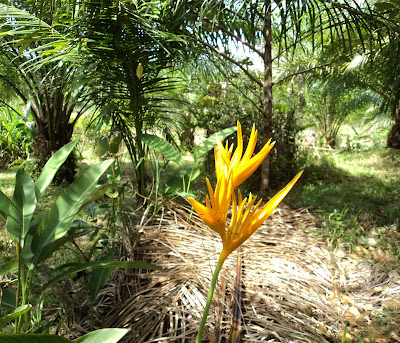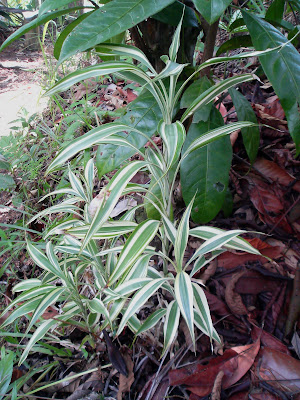
Today it rained light over the farm and thus I was able to brave the rain for a short but important task. At around 3.00 pm I decided to widen the stream, clear the sides of roots and debris ( twigs, silt) in order to improve the flow. I was working in light rain because I wanted to see those bends and corners of the stream that hold on the traffic flow. I took me about three hours of raw power to finish the job. I was happy to note how the stream improved tremendously once the debris were cleared and the sides widened. The area that I focused today was at Zone D and E. The above picture shows the stream as it meanders a section of the Heliconia Valley at Zone E area. The long shot view shows a tiny white flower at the center of the picture. It is the White Costus ( Costus speciosus ) as shown in close-up at the inset to the left. Somewhere to the right of the picture is seen a banana tree and below is the medium shot of the fruiting tree.
 There are a couple of banana varieties at the garden. Bananas belong to the genus Musa and as you can recall the popular heliconias are also of that banana family ( Family - Musaceae). I intend to build up a collection of edible varieties next year. CU of the picture above shows the purplish terminal head which Malays call " Jantung". In Malaysia the jantung are favourite for salad, of course to be eaten with the ever popular " Belacan" paste or cooked in coconut milk called " Santan". The popular banana cultivars that are readily available in Bintulu tamu or jungle produce market are the " Pisang Berangan" ( Note: " Pisang" in Malay means banana), Pisang Embun, Pisang-pisang, Pisang Hotel, Pisang Keling or Rastali, Pisang Emas, Pisang Kapok, Pisang Tanduk, and many more. Ripe bananas contain about 27% carbohydrate and surprisingly very little cholesterol or fats. They are a good source of vitamin C . The banana varieties that are commonly used for making banana fritters are the Pisang-pisang, Pisang Kapok and the Pisang Tanduk. All three are my favourites too!.
There are a couple of banana varieties at the garden. Bananas belong to the genus Musa and as you can recall the popular heliconias are also of that banana family ( Family - Musaceae). I intend to build up a collection of edible varieties next year. CU of the picture above shows the purplish terminal head which Malays call " Jantung". In Malaysia the jantung are favourite for salad, of course to be eaten with the ever popular " Belacan" paste or cooked in coconut milk called " Santan". The popular banana cultivars that are readily available in Bintulu tamu or jungle produce market are the " Pisang Berangan" ( Note: " Pisang" in Malay means banana), Pisang Embun, Pisang-pisang, Pisang Hotel, Pisang Keling or Rastali, Pisang Emas, Pisang Kapok, Pisang Tanduk, and many more. Ripe bananas contain about 27% carbohydrate and surprisingly very little cholesterol or fats. They are a good source of vitamin C . The banana varieties that are commonly used for making banana fritters are the Pisang-pisang, Pisang Kapok and the Pisang Tanduk. All three are my favourites too!.
























.jpg)
















